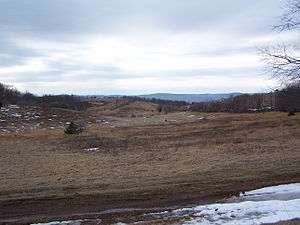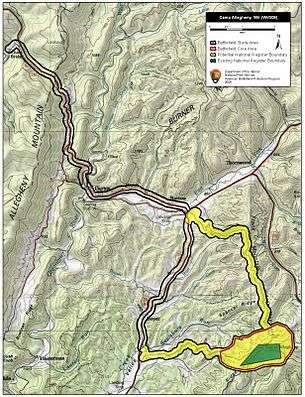Battle of Camp Allegheny
| Battle of Camp Allegheny (Battle of Allegheny Mountain) | |||||||
|---|---|---|---|---|---|---|---|
| Part of the American Civil War | |||||||
 Battlefield along Allegheny Mountain | |||||||
| |||||||
| Belligerents | |||||||
|
|
| ||||||
| Commanders and leaders | |||||||
| Robert Milroy | Edward Johnson | ||||||
| Strength | |||||||
| Brigades | Brigades | ||||||
| Casualties and losses | |||||||
| 137 | 146 | ||||||
The Battle of Camp Allegheny, also known as the Battle of Allegheny Mountain, took place on December 13, 1861, in Pocahontas County, Virginia (now West Virginia) as part of the Operations in Western Virginia Campaign during the American Civil War.[1]
Background
In December, Confederate forces under Col. Edward Johnson occupied the summit of Allegheny Mountain to defend the Staunton and Parkersburg Turnpike. A Union force under Brig. Gen. Robert H. Milroy attacked Johnson at sunrise on December 13.[1]
Battle

In a piercing winter wind, fighting continued for much of the sunny morning as each side maneuvered on the hillside fields and woods to gain the advantage. On the right flank, Milroy had posted a strong force in a mountain clearing, among the fallen timber, stumps and brush, which proved to be too difficult for the Confederate infantry to drive off. A Confederate artillery battery unlimbered and unleashed a "storm of round shot and canister among them, knocking their timber defences about their heads, and making their nest too hot to hold them..." Finally, Milroy's troops were repulsed, and he retreated to his camps at Green Spring Run near Cheat Mountain. Johnson's losses were high: 25 men were killed and 97 were wounded in the engagement, plus 23 went missing.
According to one Confederate soldier in the 52nd Virginia Infantry:[2]
I had a splendid position in this battle and could see the whole fight without having to take any part in it, and I remember how I thought Colonel Johnson must be the most wonderful hero in the world, as I saw him at one point, where his men were hard pressed, snatch a musket in one hand and, swinging a big club in the other, he led his line right up among the enemy, driving them headlong down the mountain, killing and wounding many with the bayonet and capturing a large number of prisoners...
Aftermath
Johnson would receive the nickname "Allegheny" Johnson for his efforts. At year's end, he remained at Camp Allegheny with five regiments, and Henry Heth was at Lewisburg with two regiments.
Camp Allegheny Historic District
|
Camp Allegheny | |
  | |
| Location | County Route 3, just east of County Route 5 at Top of Allegheny, near Bartow, West Virginia |
|---|---|
| Area | 105 acres |
| Built | 1861 |
| NRHP reference # | 90001446[3] |
| Added to NRHP | September 28, 1990 |
The Camp Allegheny Historic District is a national historic district encompassing one contributing structure and four contributing sites. They are the earthworks, site of hut and campground, cemetery, church site, and the site of the Yeager farmstead.[4]
It was listed on the National Register of Historic Places in 1990.[3]
See also
- Monongahela National Forest
- White Top — site of Union Army camp several miles west on Cheat Mountain
References
- 1 2 3 "Battle Summary". National Park Service. Retrieved 12 December 2016.
- ↑ Robson, John S (1898). How a One-Legged Rebel Lives: Reminiscences of the Civil War: The Story of the Campaigns of Stonewall Jackson, as Told by a High Private in the "Foot Cavalry". Durham NC: The Educator Co. pp. 20–1. Archived from the original on 2005-09-23. Retrieved 12 December 2016.
- 1 2 National Park Service (2010-07-09). "National Register Information System". National Register of Historic Places. National Park Service.
- ↑ Kim A. McBride (November 1989). "National Register of Historic Places Inventory Nomination Form: Camp Allegheny" (PDF). State of West Virginia, West Virginia Division of Culture and History, Historic Preservation. Retrieved 2011-09-01.
Further reading
- Woodward, Eddie. "An Affair of Outposts: The Battle of Alleghany Mountain," West Virginia History 59: 1-35 (2003).
- Woodward, Eddie. "Crashing the Party: Alcohol & Alcohol Abuse within the Confederate Army of the Northwest," Civil War Times Illustrated 40(6): 48-54 (December 2001).
External links
- Battle of Allegheny Mountain West Virginia Legislative Hand Book, 1928, West Virginia Archives and History
- Video tour of Camp Allegheny battlefield
